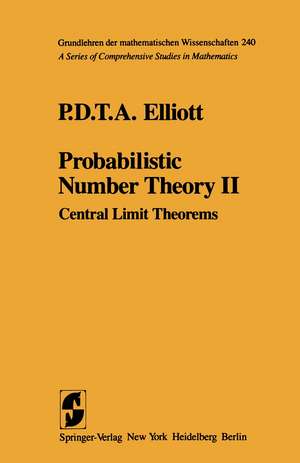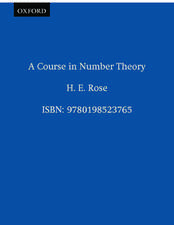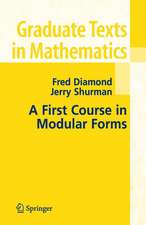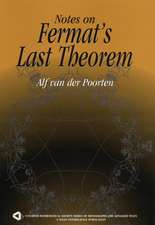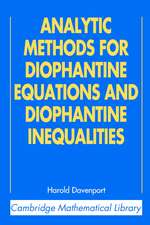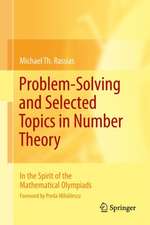Probabilistic Number Theory II: Central Limit Theorems: Grundlehren der mathematischen Wissenschaften, cartea 240
Autor P.D.T.A. Elliotten Limba Engleză Paperback – 7 dec 2011
Din seria Grundlehren der mathematischen Wissenschaften
-
 Preț: 353.84 lei
Preț: 353.84 lei - 24%
 Preț: 728.15 lei
Preț: 728.15 lei -
 Preț: 410.22 lei
Preț: 410.22 lei - 24%
 Preț: 587.88 lei
Preț: 587.88 lei - 17%
 Preț: 498.74 lei
Preț: 498.74 lei -
 Preț: 592.77 lei
Preț: 592.77 lei - 20%
 Preț: 692.50 lei
Preț: 692.50 lei - 24%
 Preț: 893.31 lei
Preț: 893.31 lei - 20%
 Preț: 824.75 lei
Preț: 824.75 lei - 24%
 Preț: 632.98 lei
Preț: 632.98 lei - 15%
 Preț: 596.69 lei
Preț: 596.69 lei - 15%
 Preț: 714.49 lei
Preț: 714.49 lei -
 Preț: 333.03 lei
Preț: 333.03 lei - 15%
 Preț: 473.16 lei
Preț: 473.16 lei -
 Preț: 356.49 lei
Preț: 356.49 lei -
 Preț: 484.43 lei
Preț: 484.43 lei - 15%
 Preț: 452.79 lei
Preț: 452.79 lei -
 Preț: 456.66 lei
Preț: 456.66 lei - 15%
 Preț: 708.75 lei
Preț: 708.75 lei -
 Preț: 423.08 lei
Preț: 423.08 lei - 15%
 Preț: 444.29 lei
Preț: 444.29 lei - 15%
 Preț: 527.79 lei
Preț: 527.79 lei - 15%
 Preț: 589.65 lei
Preț: 589.65 lei -
 Preț: 353.40 lei
Preț: 353.40 lei - 18%
 Preț: 727.66 lei
Preț: 727.66 lei -
 Preț: 387.96 lei
Preț: 387.96 lei - 15%
 Preț: 454.74 lei
Preț: 454.74 lei - 15%
 Preț: 481.03 lei
Preț: 481.03 lei -
 Preț: 464.55 lei
Preț: 464.55 lei -
 Preț: 348.77 lei
Preț: 348.77 lei -
 Preț: 362.04 lei
Preț: 362.04 lei -
 Preț: 488.12 lei
Preț: 488.12 lei - 15%
 Preț: 447.57 lei
Preț: 447.57 lei -
 Preț: 419.81 lei
Preț: 419.81 lei -
 Preț: 388.52 lei
Preț: 388.52 lei -
 Preț: 419.21 lei
Preț: 419.21 lei - 15%
 Preț: 581.01 lei
Preț: 581.01 lei -
 Preț: 497.75 lei
Preț: 497.75 lei -
 Preț: 360.53 lei
Preț: 360.53 lei -
 Preț: 387.75 lei
Preț: 387.75 lei -
 Preț: 419.81 lei
Preț: 419.81 lei - 18%
 Preț: 725.75 lei
Preț: 725.75 lei -
 Preț: 453.78 lei
Preț: 453.78 lei -
 Preț: 386.39 lei
Preț: 386.39 lei
Preț: 645.47 lei
Preț vechi: 759.37 lei
-15% Nou
Puncte Express: 968
Preț estimativ în valută:
123.51€ • 132.08$ • 102.98£
123.51€ • 132.08$ • 102.98£
Carte tipărită la comandă
Livrare economică 18 aprilie-02 mai
Preluare comenzi: 021 569.72.76
Specificații
ISBN-13: 9781461299943
ISBN-10: 1461299942
Pagini: 400
Ilustrații: 375 p.
Dimensiuni: 155 x 235 x 21 mm
Greutate: 0.56 kg
Ediția:Softcover reprint of the original 1st ed. 1980
Editura: Springer
Colecția Springer
Seria Grundlehren der mathematischen Wissenschaften
Locul publicării:New York, NY, United States
ISBN-10: 1461299942
Pagini: 400
Ilustrații: 375 p.
Dimensiuni: 155 x 235 x 21 mm
Greutate: 0.56 kg
Ediția:Softcover reprint of the original 1st ed. 1980
Editura: Springer
Colecția Springer
Seria Grundlehren der mathematischen Wissenschaften
Locul publicării:New York, NY, United States
Public țintă
ResearchCuprins
Volume II.- 11. Unbounded Renormalisations: Preliminary Results.- 12. The Erdös-Kac Theorem. Kubilius Models.- Definition of Class H.- Statement of Kubilius’ Main Theorem.- Archetypal Application of a Kubilius Model.- Analogue of the Feller—Lindeberg Condition.- The Erdös-Kac Theorem.- Turán’s Letter.- Remarks upon Turan’s letter; LeVeque’s Conjecture.- Erdös at Kac’ Lecture.- Kac’ Letter.- Remarks upon Kac’ Letter.- Further Examples.- Analogues on Shifted Primes.- Example.- Further Analogues on Shifted Primes, Application of Lévy’s Distance Function.- Examples.- Additive Functions on the Sequence N-p, p Prime.- Barban’s Theorem on the Normal Order of f(p + 1).- Additive Functions on Polynomials.- Additive Functions on Polynomials with Prime Arguments.- Further Theorems and Examples.- Quantitative Form of the Application of a Kubilius Model.- Concluding Remarks.- 13. The Weak Law of Large Numbers. I.- Theorem Concerning the Approximation of Additive Functions by Sums of Independent Random Variables.- Essential Lemma (Lemma 13.2).- Concluding Remark.- 14. The Weak Law of Large Numbers. II.- Statement of the Main Results.- The Approximate Functional Equation for ?(x).- of Haar Measures.- of Dirichlet Series, Fourier Analysis on R.- Study of the Integrals J.- Approximate Differential Equation.- A Compactness Lemma.- Solution of the Differential Equation.- Further Study of Dirichlet Series.- The Decomposition of ?(x).- Proof of Theorem (14.1) (Necessity).- Proof of Theorem (14.1) (Sufficiency).- Proof of Theorem (14.2).- Concluding Remark.- 15. A Problem of Hardy and Ramanujan.- Theorems of Birch and Erdös.- The Hardy—Ramanujan Problem. Statement of Theorem.- Commentary on the Method of Turán.- Examples.- Concluding Remarks.- 16. General Laws for Additive Functions. I: Including the Stable Laws.- Statement of Isomorphism Theorem.- Stable Laws.- Convergence to Normal Law.- Convergence to Cauchy Law.- Fractional Part of p ? 2, p Prime 13?.- Construction of the Stable Laws.- The Cauchy Law.- Concluding Remarks.- 17. The Limit Laws and the Renormalising Functions.- Growth of?(x), (Theorem (17.1)).- Class M Laws.- Continuity of Limit Law (Theorem (17.2)).- Laws of Class L are Absolutely Continuous (Lemma (17.11), Zolotarev).- Laws Which Cannot Occur.- The Poisson Law.- Further Continuity Properties.- Conjectures.- Conjectures (Summing Up).- 18. General Laws for Additive Functions. II: Logarithmic Renormalisation.- Statement of the Main Theorems.- Example of Erdös.- Non-infinitely Divisible Law.- Concluding Remarks.- 19. Quantitative Mean-Value Theorems.- Statement of the Main Results.- Reduction to Application of Parseval’s Theorem (Lemma (19.5)).- Upper Bounds for Dirichlet Series (Lemma (19.6)).- The Prime Number Theorem.- Axer’s Lemma (Lemma (19.8)).- Primes in Arithmetic Progression; Character Sums.- L-Series Estimates (Theorem (19.9)).- The Position of the Elementary Proof of the Prime Number Theorem in the Theory of Arithmetic Functions.- Hardy’s Copenhagen Remarks.- Bohr’s Address at the International Mathematics Congress.- Elementary Proof of Prime Number Theorem.- Method of Delange.- Method of Wirsing.- Theorem of Wirsing.- Historical Remark on the Application of Parseval’s Identity.- Ingham’s Review.- Concluding Remarks.- 20. Rate of Convergence to the Normal Law.- Theorem of Kubilius and Improvements (Theorem (20.1)).- Examples.- Additive Functions on Polynomials.- Additive Functions on Polynomials with Prime Arguments.- Examples.- Conjugate Problem (Theorem (20.4)).- Example.- Improved Error Term for a Single Additive Function.- Statement of the Main Theorem, (Theorem (20.5)).- Examples.- Concluding Remarks.- 21. Local Theorems for Additive Functions.- Existence of Densities.- Example of Rényi.- Hardy—Ramanujan Estimate.- Local Behaviour of Additive Functions Which Assume Values 0 and 1.- Remarks and Examples.- Connections with Hardy and Ramanujan Inequality.- Uniform Local Upper Bound (Theorem (21.5)).- Concluding Remarks.- 22. The Distribution of the Quadratic Class Number.- Statement of the Theorem.- Approximation by Finite Euler Products.- An Application of Duality.- Construction of the Finite Probability Spaces.- Approximation by Sums of Independent Random Variables.- Concluding Remarks.- 23 Problems.- References (Roman).- References (Cyrillic).- Author Index.
